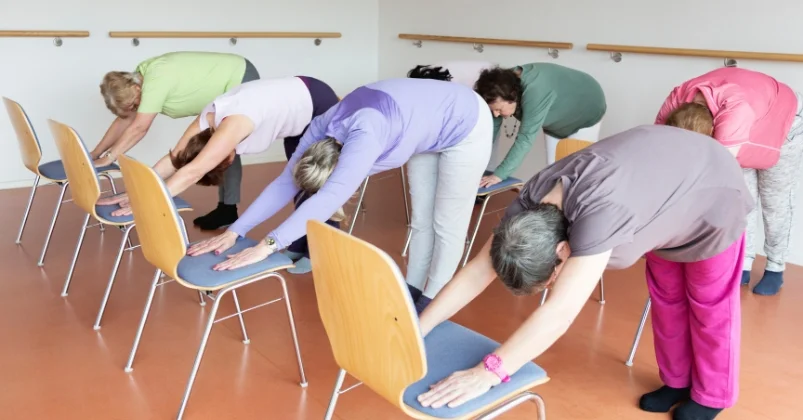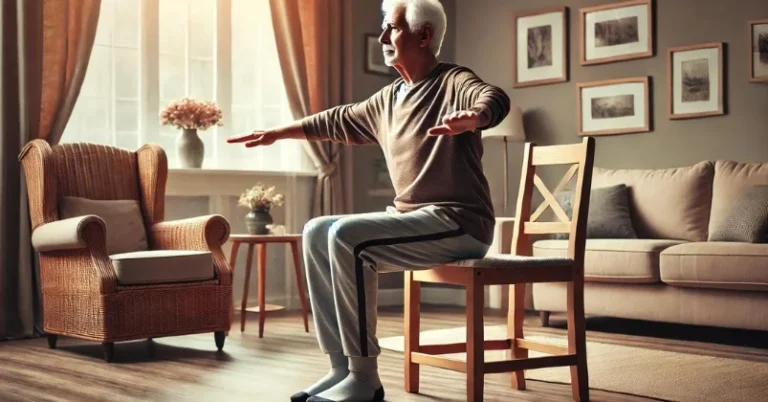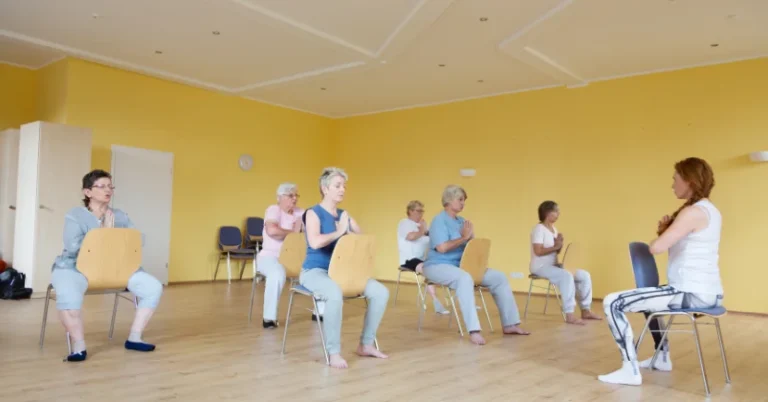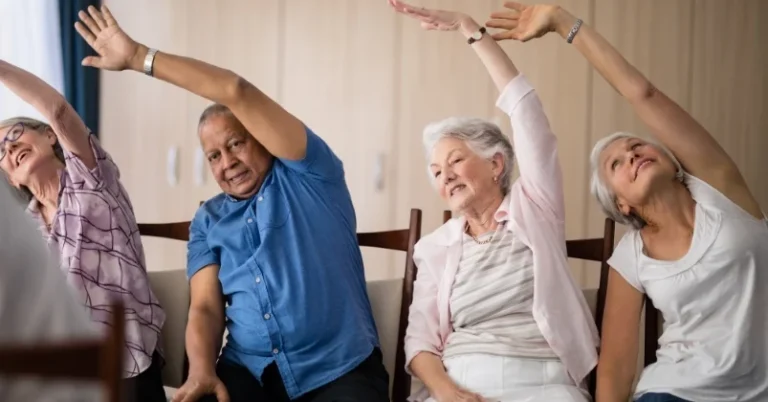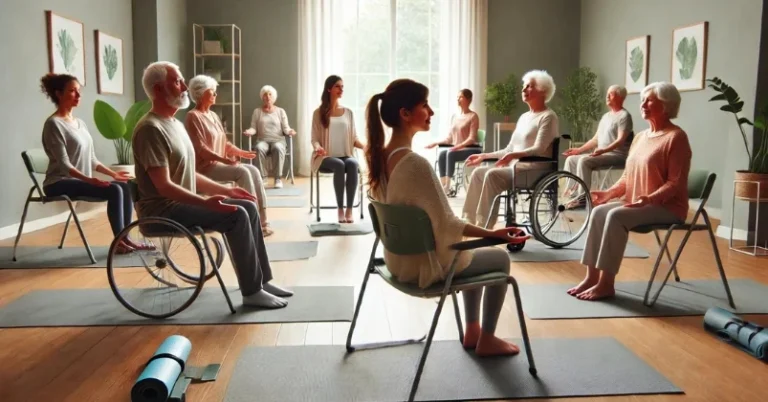Manage Arthritis with Chair Exercises: Simple and Effective Techniques
Arthritis touches the lives of countless individuals, making everyday tasks feel like uphill battles. But did you know, a delightful chair and some cheerful spirit can be the trusty sidekicks in your quest for relief?
Especially if you're among the many who find it tough to move around with the same zest as before.
Chair exercises are like the unsung heroes of the fitness world. Gentle on the joints, these workouts offer a low-impact routine without compromising on the benefits.
Think of them as your mini fitness studio, right in the comfort of your living room, garden, or even your patio as you sip on your morning coffee. Perfect for those of us who might not feel like dancing up a storm but still want to groove to the rhythm of health.
In this guide, we'll unwrap the wonders of chair exercises tailored for arthritis management. You'll find a medley of movements that can be done seated, accompanied by crystal-clear instructions.
Plus, we'll pepper in some safety tips to ensure you're getting the most out of your routine. Whether you're on a mission to reignite your mobility, melt away pain and stiffness, or just add a sprinkle of activity to your day, chair exercises might just be the missing piece in your wellness puzzle.
Join us as we dive into a world where your chair isn't just a place to rest, but a passport to better health!
Understanding Arthritis
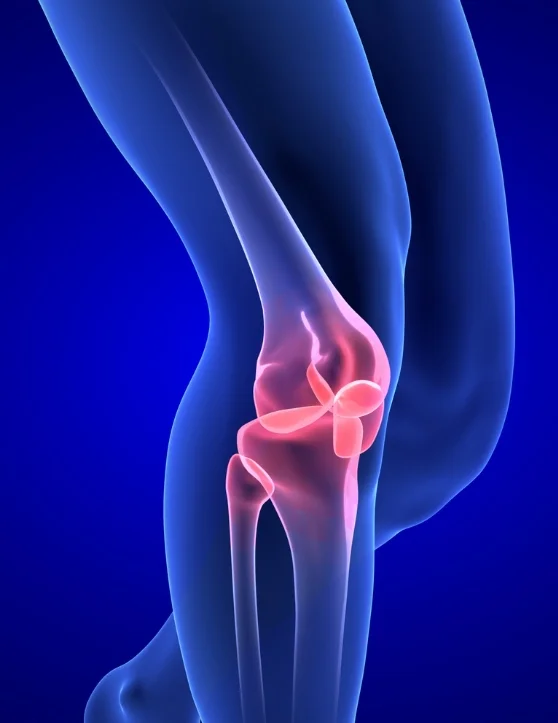
Arthritis is a condition that causes inflammation in the joints, leading to chronic pain and stiffness. It is a common condition that affects millions of people worldwide. There are several types of arthritis, including rheumatoid arthritis, osteoarthritis, and psoriatic arthritis. Each type of arthritis has different causes, symptoms, and treatments.
Rheumatoid arthritis is an autoimmune disease that causes the immune system to attack the joints, leading to inflammation and damage. Osteoarthritis, on the other hand, is caused by wear and tear on the joints over time. Psoriatic arthritis is a type of arthritis that affects people with psoriasis, a skin condition that causes red, scaly patches on the skin.
Arthritis can cause joint pain, stiffness, and swelling, making it difficult to perform daily tasks. It can also lead to reduced mobility and a decreased quality of life. However, there are several ways to manage arthritis, including exercise, medication, and lifestyle changes.
Regular exercise is essential for managing arthritis. Chair exercises can be an excellent option for people who have difficulty standing or moving around. These exercises can help improve flexibility, strength, and range of motion, reducing joint pain and stiffness.
In addition to exercise, medication can help manage arthritis symptoms. Nonsteroidal anti-inflammatory drugs (NSAIDs) can help reduce inflammation and relieve pain. Disease-modifying antirheumatic drugs (DMARDs) can slow the progression of rheumatoid arthritis and other autoimmune diseases.
Lifestyle changes can also help manage arthritis symptoms. Maintaining a healthy weight can reduce the stress on joints, leading to less pain and inflammation. Eating a healthy diet rich in fruits, vegetables, and whole grains can also help reduce inflammation and improve overall health.
Arthritis is a common condition that can cause chronic pain and stiffness in the joints. There are several types of arthritis, each with different causes, symptoms, and treatments. Managing arthritis requires a combination of exercise, medication, and lifestyle changes. Chair exercises can be an excellent option for people who have difficulty standing or moving around.
Benefits of Exercise for Arthritis
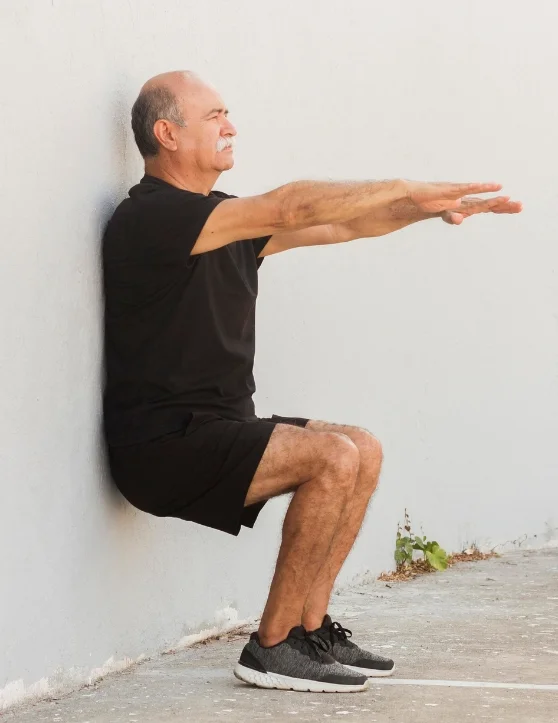
Exercise is an important part of managing arthritis. Regular physical activity can improve flexibility, mobility, and range of motion. Exercise can also help manage arthritis pain and improve overall quality of life.
One of the benefits of exercise is that it can improve mental health and mood. Exercise has been shown to reduce anxiety and depression, which are common in people with arthritis. Exercise can also help prevent heart disease and maintain a healthy weight.
In addition to improving mental health, exercise can also improve physical function. Regular exercise can help maintain muscle strength and bone strength, which is important for people with arthritis. Exercise can also improve physical function, making it easier to perform daily activities.
There are different types of exercise that can benefit people with arthritis. Range-of-motion exercises can help reduce stiffness and improve flexibility. Strengthening exercises can help maintain muscle strength and improve physical function. Aerobic exercise can improve heart health and help maintain a healthy weight.
It is important to talk to a healthcare provider before starting an exercise program, especially if you have arthritis. They can help you develop an exercise plan that is safe and effective for you.
Chair Exercises for Arthritis
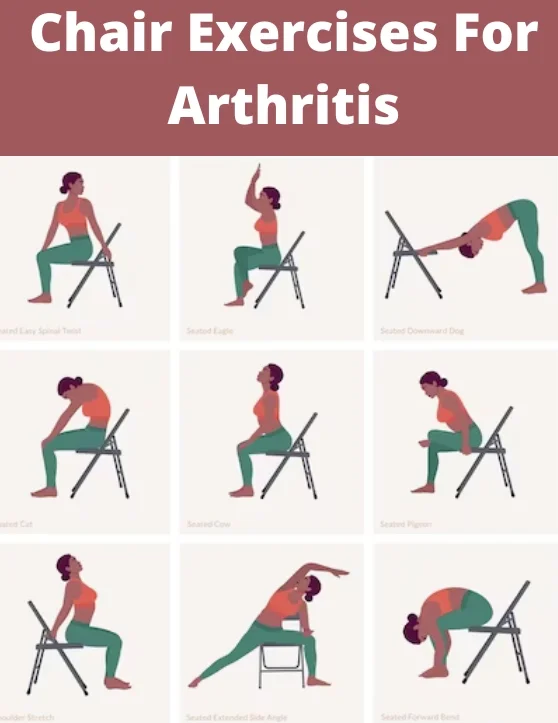
For individuals with arthritis, low-impact exercises can be a great way to stay active and manage symptoms. Chair exercises are a type of low-impact exercise that can help reduce pain and stiffness, build muscle, improve flexibility, and better balance.
Chair exercises are a great option for those who have difficulty standing or walking for long periods of time. They are also a low risk of injury, making them a safe and effective option for those with arthritis.
When starting an exercise program, it is important to consult with a healthcare provider to determine which exercises are safe and appropriate for your condition.
Here are some chair exercises that can be incorporated into an arthritis exercise program:
Stretching Exercises
- Neck rotations
- Neck stretch
- Side bend
- Chest stretch
- Hip marching
Strengthening Exercises
- Leg lifts
- Thigh squeeze
- Arm raises
- Upper body twist
- Chair rise
Aerobic Exercises
- Seated marching
- Seated jumping jacks
- Seated side steps
- Seated leg cycling
Incorporating these exercises into a regular routine can help improve overall health and well-being for individuals with arthritis.
Specific Chair Exercises
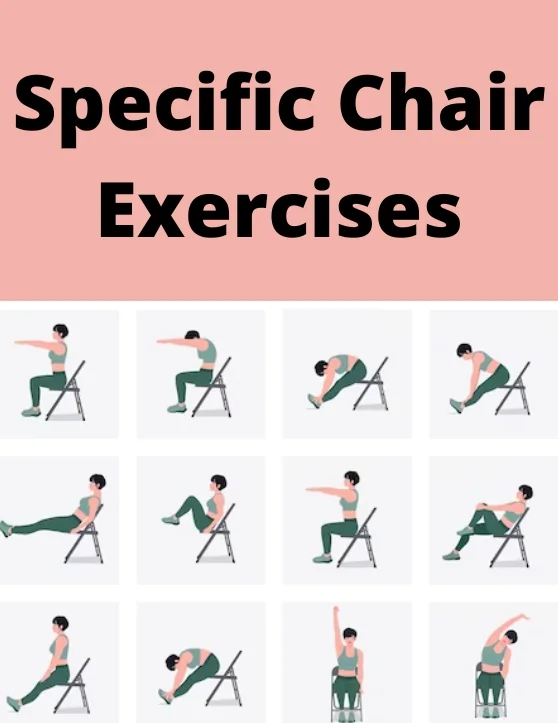
When it comes to managing arthritis, chair exercises can be very helpful. They are low-impact, easy to do, and can be done anywhere. Here are some specific chair exercises that can help alleviate arthritis symptoms.
Upper Body Exercises
Shoulder Rolls
Shoulder rolls are a great way to loosen up your shoulders and relieve tension. Sit up straight in your chair and roll your shoulders forward in a circular motion. Repeat this 10 times and then switch to rolling your shoulders backward for another 10 reps.
Fist Stretch
This exercise helps to stretch the muscles in your fingers, wrists, and forearms. Start by making a fist with both hands and then slowly open your fingers until they are straight. Repeat this 10 times.
Knuckle Bend
This exercise helps to improve flexibility in your fingers and hands. Start by making a fist and then bend your fingers at the knuckles until they touch your palm. Hold this position for a few seconds and then release. Repeat this 10 times.
Lower Body Exercises
Sit and Stand
This exercise helps to strengthen your legs and hips. Sit on the edge of your chair with your feet flat on the ground. Slowly stand up and then sit back down. Repeat this 10 times.
Ankle Circles
This exercise helps to improve mobility in your ankles and feet. Sit up straight in your chair and lift one foot off the ground. Rotate your ankle in a circular motion 10 times and then switch to the other foot.
Leg Extensions
This exercise helps to strengthen the muscles in your legs. Sit up straight in your chair and extend one leg out in front of you. Hold this position for a few seconds and then lower your leg back down. Repeat this 10 times and then switch to the other leg.
These chair exercises can help alleviate arthritis symptoms and improve your overall mobility. Incorporate them into your daily routine to experience their benefits.
Safety and Modifications

It is important to exercise safely and make modifications when necessary, especially when managing arthritis. Before starting any exercise program, consult with a healthcare professional or physical therapist to ensure that it is safe and appropriate for your individual needs.
When performing chair exercises, it is important to pay attention to proper form and technique to prevent injury. Start with a low intensity and gradually increase the intensity over time. If you experience pain or discomfort during an exercise, stop immediately and consult with a healthcare professional or physical therapist.
Modifications can be made to chair exercises to accommodate different levels of ability and mobility. For example, if an exercise requires standing up from the chair, it can be modified by using a sturdy object, such as a table or wall, for support. Additionally, exercises can be modified by adjusting the range of motion, speed, or resistance.
It is recommended to perform chair exercises at a moderate intensity, which is enough to increase heart rate and breathing, but still allows for comfortable conversation. Remember to listen to your body and adjust the intensity as needed.
Overall, chair exercises can be a safe and effective way to manage arthritis and improve overall health and fitness. With proper modifications and attention to safety, individuals can enjoy the benefits of exercise without risking injury or discomfort.
Incorporating Other Low-Impact Activities
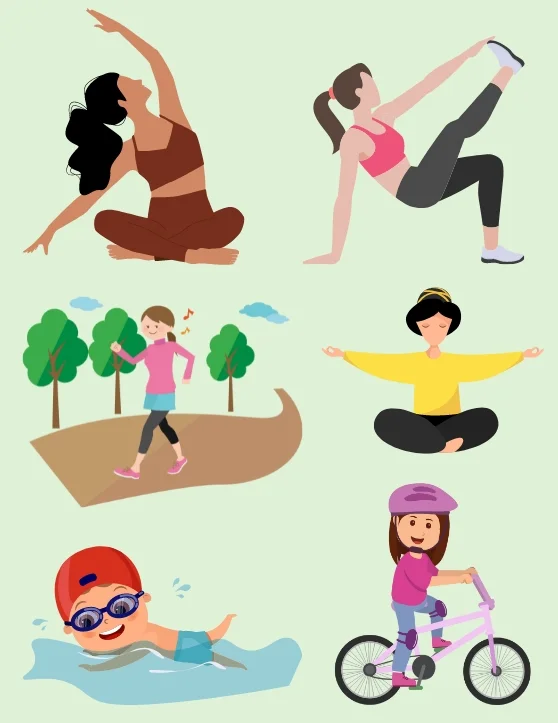
In addition to chair exercises, incorporating other low-impact activities into your routine can help manage arthritis symptoms and improve overall joint health.
Walking
Walking is a great way to improve joint mobility and flexibility without putting too much stress on your joints. It is a low-impact activity that can be done almost anywhere and at any time. Walking can also help improve cardiovascular health and boost mood.
Cycling
Cycling is another low-impact activity that can help manage arthritis symptoms. It is easy on the joints and can be done indoors or outdoors. Cycling can help improve joint mobility and flexibility, as well as build strength in the legs.
Swimming and Water Exercises
Swimming and water exercises are excellent low-impact activities for people with arthritis. They allow for a full-body workout while reducing the impact on joints. The buoyancy of the water can help reduce joint pain and stiffness, making it easier to move.
Tai Chi and Yoga
Tai chi and yoga are gentle exercises that can help improve joint flexibility and strength. They also promote relaxation and stress reduction, which can help manage arthritis symptoms. Both tai chi and yoga can be modified to accommodate different levels of ability and mobility.
Aerobic Activity
Aerobic activity, such as dancing or group exercise classes, can help improve cardiovascular health and muscle strength. It is important to choose low-impact activities that are gentle on the joints. Many gyms and fitness centers offer low-impact aerobic classes specifically designed for people with arthritis.
Incorporating a variety of low-impact activities into your routine can help manage arthritis symptoms and improve overall joint health. It is important to choose activities that are appropriate for your level of ability and mobility, and to consult with your doctor before starting any new exercise program.
Role of Diet and Rest
In addition to regular exercise, a healthy diet and adequate rest are also important for managing arthritis.
Healthy Diet
Maintaining a healthy diet can help manage arthritis symptoms and improve overall health. A balanced diet that includes plenty of fruits, vegetables, whole grains, lean protein, and healthy fats can help reduce inflammation, maintain a healthy weight, and provide the necessary nutrients for joint health.
Some foods that have been shown to have anti-inflammatory properties include fatty fish, nuts, seeds, olive oil, and berries. On the other hand, foods high in sugar, saturated fats, and processed foods may increase inflammation and worsen arthritis symptoms.
Rest
Rest is also an important aspect of arthritis management. Adequate rest can help reduce fatigue, which is a common symptom of arthritis. It is important to balance rest with physical activity to prevent joint stiffness and maintain joint flexibility.
During periods of arthritis flares, it may be necessary to rest more to reduce inflammation and pain. However, it is important to resume physical activity as soon as possible to prevent joint stiffness and maintain joint function.
Excess Weight
Maintaining a healthy weight is also important for managing arthritis. Excess weight can put additional stress on joints and increase inflammation, which can worsen arthritis symptoms. Losing weight through a combination of diet and exercise can help reduce joint pain and improve joint function.
Overall, a healthy diet and adequate rest are important components of arthritis management. Incorporating these lifestyle changes along with regular exercise can help reduce inflammation, manage symptoms, and improve overall health.
“Combatting Arthritis with Chair Exercises: A Safe Route to Pain Management and Improved Well-being”
Chair exercises can be a safe and effective way for patients with arthritis to manage their pain and improve their overall well-being. According to the Arthritis Foundation, exercising with arthritis can help reduce joint pain and stiffness, increase flexibility and range of motion, and improve the immune system.
The Centers for Disease Control and Prevention recommends that older adults should aim for at least 150 minutes of moderate-intensity aerobic activity per week, as well as muscle-strengthening activities two or more days a week. Chair-based exercises can help seniors achieve these goals, as they are low-impact and can be modified to fit individual needs and abilities.
When creating a treatment plan for arthritis, it is important to consult with a healthcare provider to determine the best exercises for each patient's specific condition. Range-of-motion exercises, strengthening exercises, and aerobic exercise are all important components of a well-rounded exercise routine for patients with arthritis.
Overall, chair-based exercises can be a valuable tool for managing arthritis pain and improving physical function in older adults with lower extremity osteoarthritis, according to a pilot randomized controlled trial published in the National Library of Medicine. By incorporating chair exercises into their daily routine, seniors can improve their quality of life and maintain their independence.
FAQs
A: Chair exercises are a great way to manage arthritis pain, especially for those with limited mobility. Some effective chair exercises include leg lifts, seated marches, and seated twists. These exercises can help improve flexibility, strengthen muscles, and reduce joint pain.
A: Seniors with arthritis can benefit from low-impact exercises that are easy on the joints. Chair exercises, such as seated leg extensions and seated arm curls, can help improve strength and flexibility. Walking and swimming are also great exercises for seniors with arthritis.
A: Hand exercises can help manage arthritis pain and improve hand strength. Some effective hand exercises include finger bends and finger lifts. Squeezing a stress ball or using a grip strengthener can also help improve hand strength.
A: Arthritis in the fingers can be painful and limit mobility. Finger stretches, finger taps, and finger lifts are some recommended exercises for arthritis in fingers. These exercises can help improve flexibility and reduce pain.
A: Strength exercises can help manage arthritis pain and improve overall health. Some safe strength exercises for managing arthritis include bicep curls, tricep extensions, and leg presses. It is important to start with light weights and gradually increase as strength improves.
A: High-impact exercises, such as running and jumping, should be avoided for osteoarthritis. These exercises can put too much stress on the joints and worsen arthritis pain. It is important to stick to low-impact exercises, such as walking, swimming, and cycling, to manage osteoarthritis pain.

